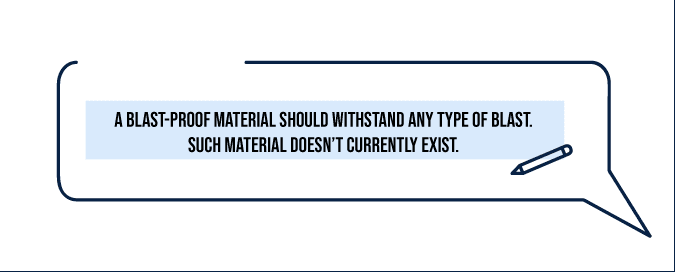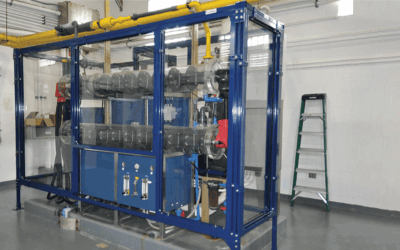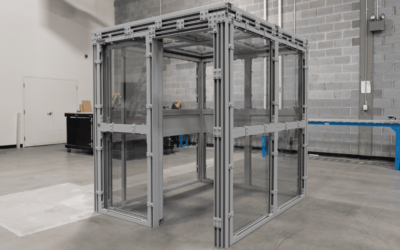The terms “blast-proof” and “explosion-proof” are widely used within the shield enclosures and protective materials industry. Our customers often ask for a “bulletproof” enclosure or an “explosion-proof” shielding room. Many visitors arrive at our site by using these search terms.
While the phrases are commonly used, we strive to use the correct vocabulary. Let’s be straightforward: there’s no such thing as a blast-proof product. Keep reading and find out why you should avoid using these terms.
Blast-Resistant vs. Blast-Proof
It may sound nit-picking, but the terms “blast-proof” or “explosion-proof” imply that something can be made impervious to any type of explosion. The reality is that currently, no material nor product can resist damage from a large enough blast or explosion.
There is similar confusion about the term “bulletproof.” Manufacturers of “bulletproof vests” quickly point out that their products are only rated to stop bullets of a specific mass and velocity, and then only when the product is otherwise in new condition and has not been previously impacted. A bulletproof vest might be rated to stop a 38 caliber bullet, but if a second bullet impacts the vest near the first strike, the vest might fail.
In other words, all shielding materials could fail under different scenarios. It would only take different conditions on the testing, such as a bigger blast or caliber bullet, to affect a product’s performance.
For a product to be considered blast, bullet, or explosion-proof, it should be able to contain any type of blast regardless of the conditions surrounding it.

We prefer the terms “blast-resistant” and “explosion-resistant,” and you will see these terms used on our website and literature. While no shielding room, shield enclosure, or shielding blanket in the market can be blast-proof, they can be blast-resistant if engineered and tested to safely contain a specific amount of energy before failure.
For this reason, we prefer using the term blast-resistant or explosion-resistant for our shielding solutions.
A common use of TotalShield blast-resistant enclosures is to protect staff while testing a component using compressed air. These components can rupture under pressure, resulting in a violent release of energy, a “blast wave”, and debris. See our blog about the Differences between pneumatic and hydrostatic pressure testings to learn more about it.
For our explosion-resistant enclosures, we design them for possible explosions related to chemical reactions – for example, the ignition of flammable gas or other explosive chemical reactions.
What about ballistic-resistant enclosures?
To make this slightly more confusing, people also use the term “ballistic-resistant.” It expresses a similar idea to “bulletproof” / “bullet-resistant.” Ballistic-resistant refers to the ability to protect against an object in flight. TotalShield customers often work with equipment that might send an object flying under a failure scenario.
Think of a spinning turbine that expels fan blade fragments at high speed upon failure or a centrifuge that fails and sends its payload outward at high velocity. These objects are traveling ballistically, and we can engineer shielding products that can withstand the impact of these high-speed and potentially lethal objects. While they are not bullets, you can think of them as acting like a bullet, and just like a “bulletproof vest”, our shielding products are designed to stop the object before it causes injury.
In the following video, you can see one of the tests we have conducted for ballistic impact. You can watch as the polycarbonate panel is impacted by a 32-pound steel projectile traveling at 85 feet per second.
The panel dissipates energy by first moving in the proprietary TotalShield gasketed frame and then deforming elastically. Our manufacturing processes avoid any stress points, protrusions, or polycarbonate incursions that might concentrate stress or strain forces and result in failure of the panel.
Standards for Blast Resistance
There are a few different blast resistance standards for windows and buildings, and bullet resistance standards for bullet-resistant products such as security glass and security barriers.
The table below summarizes some of the existing standards.
| Standard | Description |
| NIJ Standard 0108.01“Ballistic Resistant Protective Materials” | “The purpose of this standard is to establish minimum performance requirements and methods of test for ballistic-resistant protective materials.” |
| UL 752“Standard for Bullet-Resisting Equipment” | “1.1 These requirements cover materials, devices, and fixtures used to form bullet-resisting barriers which protect against robbery, holdup, or armed attack such as those by snipers.1.1.1 This standard can also be used to determine the bullet resistance of building components that do not fit the definition of equipment, such as windows, walls, or barriers made out of bullet-resistant materials.1.2 As used in these requirements, the term “bullet-resisting” signifies that protection is provided against complete penetration, passage of fragments of projectiles, or spalling (fragmentation) of the protective material to the degree that injury would be caused to a person standing directly behind the bullet-resisting barrier.” |
| ASCE 59-11:“Blast Protection of Buildings – Blast-Resistant Design of Systems, and Components” | “Blast Protection of Buildings provides minimum requirements for planning, design, construction, and assessment of new and existing buildings subject to the effects of accidental or malicious explosions. The Standard includes principles for establishing appropriate threat parameters, levels of protection, loadings, analysis methodologies, materials, detailing, and test procedures. It provides a comprehensive presentation of current practice in the analysis and design of structures for blast resistance. Commentaries on the requirements are also included. The Standard supplements existing building codes, standards, and laws, but is not intended to replace them.” |
These standards, however, aren’t directly applicable to an industrial setting.
For example, a customer that uses a high-speed centrifuge and wants to provide a safety enclosure to protect against a possible machine failure is not really looking for a bulletproof or blast-resistant enclosure. Instead, they are looking for a ballistic-resistant enclosure that can protect staff from the failure of the centrifuge, taking into account the speed of the centrifuge and the size and mass of the centrifuge payloads.
That is why every TotalShield product is custom-designed by our engineers to protect against a defined threat level. In the example given above regarding a high-speed centrifuge, our engineers would work with the customer to understand the following:
- What is the maximum rotational speed of the centrifuge?
- What is the diameter?
- Is there a primary containment installed for the centrifuge? If so, what are the properties of this containment?
- What is the size and mass of potential projectiles, such as centrifuge payload, bolts, etc.?
Using these data points, our engineers analyze the ballistic energies associated with multiple failure modes and design an enclosure that will reliably protect personnel in the event of a machine failure.
Each product is delivered with a Letter Report that details the design methodology and analysis used, the specific assumptions made, and calculations used; it also includes references to material manufacturer testing and TotalShield’s proprietary test archive compiled over 25 years.
You can find an example of our proprietary testing used in designing a ballistic-resistant shielding room below:
“TotalShield has impacted 1/2 inch thick polycarbonate mounted in our proprietary framing with a 32 lb steel projectile traveling at 85 ft/s, which corresponds to an impact energy of approximately 3593 ft lb (4871 J).”
Putting It All Together
Our customers engage in a number of different activities across many industries: designing rocket motors, engineering turbines, running power generation equipment, or maintaining heat exchangers. They all share one thing in common: they care about the safety of their employees.
So while our customers might use the terms “bulletproof”, “blast-proof”, “ballistic resistant”, or “explosive resistant” interchangeably, we know what they mean. They want to keep their people safe. At TotalShield, we will work with your staff to define and quantify the threat and then design a custom solution that will do just that.









